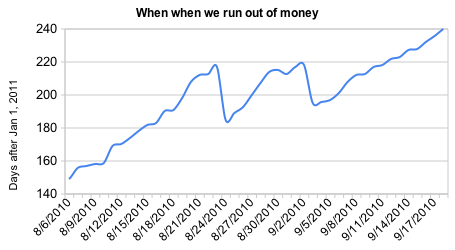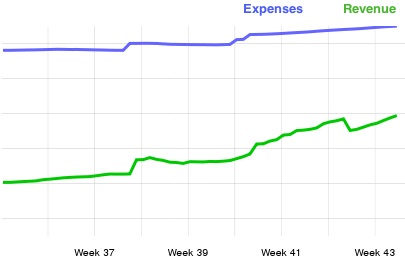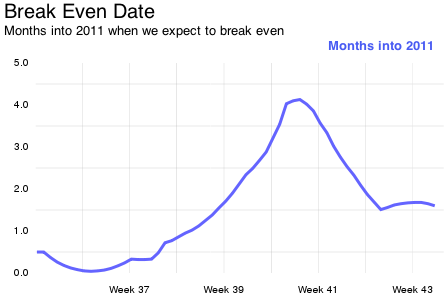A few months ago I created a fun device at WPEngine to focus everyone’s attention the most important thing.
If nothing changes, when will you run out of money?
Sometimes fear is a good motivator. In this case, fear takes the form of a tiny spreadsheet:

I know it’s looks silly to name the very day that we run out of money — why not include the hour and minute too? Clearly it’d be more accurate to say “sometime in Q1 2011.”
But the goal here isn’t accuracy, it’s motivation and focus. Nothing drives correct thinking about getting to profitability like facing your own demise. No hedging, no estimating, no complex Profit & Loss projections, just a date.
Confronted by an ultimatum, your thoughts crystalize. Maybe some of those things on your to-do list for this week aren’t as important as you thought. Maybe you could get v1.0 out the door faster. Maybe you should be spending your time getting revenue instead of ruminating on the philosophy of startups with strangers in the comment section of some blog. (Err, except for this blog of course!)
[UPDATE: @rjrodger created an awesome, easy tool for this at http://startupdeathclock.com/]
So did it work?
Four minutes after emailing this internally someone responded with a way for us to launch a week earlier than planned. Three minutes after that another email appeared with a focused list of “must-haves” before release (with a few items omitted from the previous “must-have” list).
Yeah, it works. Try it!
Tracking Progress
Of course as you improve your profitability — hopefully through more revenue but possibly through lower expenses — this date will change. Tracking that change over time is an easily-digestible demonstration of progress, and/or acceleration of progress.
Here’s our actual data:

It’s easy to see that we’re replacing our burn to some extent, with a notable down-spike when we make a new investment that eats cash. It’s a particularly nice way to visualize just how big of an investment we made, and how subsequent income replaces it (or doesn’t).
Even better: Tracking your break-even date
Tracking “death” is good motivation, but it’s so negative! If you actually have revenue — and it’s growing, and growing faster than expenses — there’s another more positive and more useful way to plot your progress: Your anticipated break-even date.
Here’s how we generate this date for WPEngine. First we track our expenses measured daily as “monthly accural revenue for past 30 days.” Put another way, if 100% of our expenses for this month (salaries, servers, bandwidth, credit cards) were paid on a single day, how much would it be?
Second we track the same concept but with revenue. Our customers pay us monthly, but everyone is on a different day of the month (specifically, 15 days after they signed up, when their trial expired).
The result looks like this (dollars intentionally omitted… there’s a limit to transparency!):

We can see that revenue is catching up with expenses, so how do we project when that date will be?
The idea is to approximate both of these curves with straight lines and see where they’d intersect. The simplest linear estimation is to just draw a line between the first and last point in the window and project from there, but this products erratic results due to the normal bumps and dips in the graphs. So it turns out you need to use least-squares regression to generate approximation lines that are relatively immune to minor undulations. Determining the x-value for where the two lines intersect is as easy as setting the linear equations equal and solving for x.
(For those of you actually following along with the math, remember that what you’ve just computed is the number of days from the beginning of the data window that the two lines intersect. I also convert that into an actual date, e.g. March 14th, 2011, not a relative date, e.g. 127 days from “now.”)
The result is worth the effort; here’s our projected break-even date over time:

When the date is moving out it means we’re being less efficient (either at expenses or revenues or both), and the same in reverse. Recently it’s stabilized which is a good sign that we’re starting to lock in our process, and with the break-even date much closer than our running-out-of-money date, we’re confident we won’t run out of money.
And perhaps most importantly of all, as soon as anything changes for the worse, we see it. No surprises three months later when suddenly we realize we don’t have enough money to keep going.
It ends
As you approach cash-flow break-even, your “run out of money” date accelerates into the future. As you blow past that magical moment, your business can sustain itself indefinitely without further cash investment, and the date becomes infinite.
That’s the end of the chart. Congratulations, now there’s only 47 other metrics you need to be tracking.
Oh well, we should all be so lucky.
Let’s compare notes
What other simple, motivating metrics can you use early on in your startup? What’s your death-day? Join the conversation in the comment section.
39 responses to “Build your own Startup Death Clock”
I know people who’ve done that with death itself.
i.e. statistically based on my race, sex, demographic data etc. how long do i have left to live.
when you see those hours racing towards zero – does wonders to focus the mind and help ensure you don’t waste time on irrelevancies.
Now that’s a thought.
How did it impact those people over time?
Any remarkable results?
I’ve done it with a plot, but it didn’t affect me as far as I can tell. The estimated date is so far out that day-to-day you don’t see any changes in the remaining-lifetime plot. If you want it, here’s the google gadget I made: http://www.google.com/ig/adde?moduleurl=http://hosting.gmodules.com/ig/gadgets/file/114884106867150705065/lifevis3.xml&source=imag, and here’s what I used to calculate life expectancy: http://gosset.wharton.upenn.edu/mortality/.
This is a great idea Jason, we’ll be developing something similar internally as well now, nothing like keeping you focused when you know how long you have to live. Hope your days and our days past Jan 1 2011 keep increasing :).
I worked at place that clearly stated and tracked the break even date like that. It was a huge motivator and focal point. It was discussed at every company meeting and everyone knew where we were wrt to breaking even. It was so helpful and seemed so obvious, I wondered why I had never worked anywhere that did that before.
It helps to have a simple approach to accounting. Once you start talking about EBITA, offsets, deferred losses, etc, you can’t expect everyone to be on the same page anymore.
Agreed. For taxes you need all that complexity, but that’s something your accountants should be able to shield from you when you’re just trying to understand how money is moving and whether it’s changing.
Interesting post. It reminded me of ONO book and the video it is used to market it.
http://www.youtube.com/watch?v=v51bu6aiL0Q
Really great post Jason. A death date is something i never thought of before; your real world examples clearly demonstrate the advantages.
Finances, profitability, predictions always seem abstract to me. Seeing one graph that illustrates your companies health (quite literally) and another that shows when you break even is real.
Thanks for sharing this concept in your usual articulate manner.
Cool. I’ve been working on a tool for dealing with similar issues.
Here’s my half-baked prototype: http://valuegrapher.com/
I wrote about how I’ve been using this tool over here: http://jessealdridge.blogspot.com/
Feedback is appreciated!
@Jesse
Great idea, also have you see rescue time? (http://www.rescuetime.com/) it tracks what you do on the computer automatically so you don’t have to write it down every time you switch from one app to the next.
Looks like a neat idea. I’d like to see a real result from someone’s data to see what the surprises are.
If it can reveal something important about how I spend my time it might be worth the effort in tracking.
@Helmut
Yeah, I know Rescue Time. My main problem with it is I always use the same apps, so it doesn’t really tell me where I’m spending my time.
@Jason
Check my blog: http://jessealdridge.blogspot.com/. It has some data from my own experiences.
A tl;dr of my last post:
—
Focusing on long-term goals can cause you to neglect short-term goals. Talking to investors seems like the most time-efficient way to keep from running out of money.
—
Not exactly earth-shattering, but it’s still nice to see my assumptions confirmed by data.
As an experiment, I’m willing to e-mail people once a day and ask them what they worked on. I’d then enter their data into this tool, handle the analysis myself and send them back some feedback. If anyone is interested in taking me up on this (free) offer contact me at [email protected].
My partner and I hacked up something similar for ourselves (we call it timepie) but we’ve tried to take more of the overhead out. Instead of relying on us to log our time, timepie randomly pings us and we answer with tags for what we’re doing *right at that moment*. At first this yields noisy estimates but they’re unbiased and over time plenty accurate. (Have to be careful about the ping probability distribution so it’s ungameable.)
And instead of needing to assign values to projects, I’ve made it binary: is this a task on my task list or not? (I.e., the special case of your system where everything on the task list at all gets weight 1.) My goal is to spend >40 hours/week working and >20 hours/week working on premeditated tasks. (This comment is a good example of something that (barely) counts as work but was not on my task list — all too easy to have all your time sucked up by things like this!).
I’m not doing great at the moment:
http://beeminder.com/d/job
http://beeminder.com/d/ontask
(need to stay on those “yellow brick roads”!)
Very interesting. I think the key here is to keep the team focused and with a clear goal.
Jason, great advice. At our company, we’ve been tracking these key performance indicators (KPI) for more than 10 years. It is important to note that your forecasted result will vary depending on how conservative you are when estimating future income and expenses.
When it comes to future income, we track in two categoreies – 1) Work currently under contract and 2) New contracts w > 75% chance in closing. If the work has less than 75% chance of closing, then we do not include it in our estimates.
When it comes to future expenses, we factor fixed overhead plus variable cost of goods sold. Cost of goods will vary with income, ie 1) Work currently under contract and 2) New contracts w> 75% chance in closing.
Thus, estimating which projects have >75% chance in closing becomes a critical business planning function. Also, it is important to ensure that all work that is currently under contact, remains under contract and on schedule/budget.
Very interesting! I was also wondering if Jason preferred to skew his death clock toward the worst-case scenario (no further investment, zero customer growth).
Drawing a bright line between >75% likely-to-close contracts and everything else is very savvy. Most people just make a private mental distinction, whereas articulating it clearly to the whole team can help everyone allocate their resources more effectively. Kind of like how Best Buy made a deliberate effort to get rid of some of its low-value or negative-value customers in order to focus on their best customer segment.
Yeah I agree. Articulation of the mental model is the key. Until a strategy is articlulated, it cannot be ingrained in the work culture and thus is fairly inconsequential.
Nice post Jason.
What amazes me is that this is not dead obvious (no pun intended) yet I see entrepreneurs ignoring it all the time. Not doing this is the startup equivalent of the ostrich sticking it’s head in the sand.
-Mike
Wow, great idea Jason. This would also help immensely in initial business planning, makes it clear how much funding you need, cash flow requirements, focus on sales, etc.
Do you (or anyone here) have a mockup of an Excel sheet (or any other solution including webbased) that could do this calculation automatically, based on input of revenue and expenses?
Bonus points for least squares smoothing your estimated break even point.
This type of prediction appears highly motivating. Great news that wpengine will be cooking along sustainably (knock on wood) in only a few months. That’s beautiful.
What kind of upfront investment did it take to solidify the product, 200-300k? I expect I could setup a server quickly with a payment system, but I assume you guys tricked out the wordpress setup process in some way to be ultra smooth for users (auto-updates, high quality themes?). What’s fascinating to me is what is valued by customers, and then the path to providing and over satisfying that need.
Appreciate the candid walk through and focus on deadlines/goal dates. If you guys grow to the point of hiring, I’d love to learn first hand how operations of this size manifest and grow. My resume’s online. Of course I want to build my own business, but I still have much to learn.
I love the simplicity of it. Instead of tracking multiple metrics, you just track the most important once since all of those other metrics, are worth nothing if you run out of money.
I find that this simple tracking method is also good for projects, where you have a certain number of things to get done and when they are completed, you ship. It’s far better than a silly Gantt chart with all those 95% done line items.
Jarie
in a retail environment (ecommerce), we focused on the three below:
sales
working cap
breakeven
worked wonders
I’m afraid I really couldn’t resist: http://startupdeathclock.com
After seeing “The Social Network” I just had to stay up late building something…
This is totally awesome… tweeting and updating the main post to include…
Hey, your cool idea! Glad you liked the site.
It certainly focuses the mind.
hah, is this your first piece if “accounting” software? very cool. is it on github?
It is now: https://github.com/rjrodger/startupdeathclock
Have fun!
Good job, Richard! I must ask, how late did you stay up?
Started about 11:30PM ended about 2AM, but crashed at that point so I only put it up the next day.
Wow. Long-time reader, 1st-time commenter. Easily the most useful blog post on here to date.
At Lab Escape, we’ve been calculating our death date for the past seven years. I have a spreadsheet that tracks each expense across a hierarchy of expense categories and each bit of revenue based on when we expect it to be deposited in the bank.
Running an enterprise software company, this is even more important than with under a subscription model, because revenue spikes with large sales that need to be factored into the model. I have a bookkeeper update my “worst case scenario” model each week, which assumes we make no new sales. Then I use this to do what-if with deals in the pipeline and make decisions on where to make new investments, how to manage our credit lines and when cash gets tight, which expenses to cut or defer.
Since we’re an operating, profitable business, we actually calculate two death dates: date until net zero (when cash on hand equals debt) and date until death (when all cash on hand is used and no more credit is available).
I like the chart showing the days out on the death date. We’ve never done this, but it’s something I might go back and try.
This is a really cool metric. Definitely a must have on the startup dashboard.
Jason, I found this article very refreshing. I feel it is always good to take a different look at things now and then and at http://www.marcsmarketinghub.com I am always looking for new things to write about. I think you may have discovered a gem this time. I went back through your archives as well and read a few articles. You have a unique outlook on business that should be seriously considered by this countries fortune 500. Good work.
Cheers
Marc
http://marcsmarketinghub.com/internet-marke…aining-courses
How stupid.
If you believe in me you live forever. duh.
thanks great article and blog you have set-up, considering all the crap out there on the internet its really nice to find some good quality content like this.